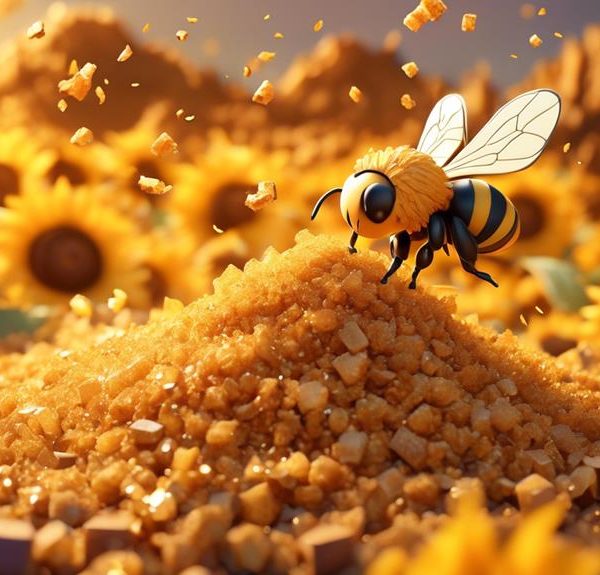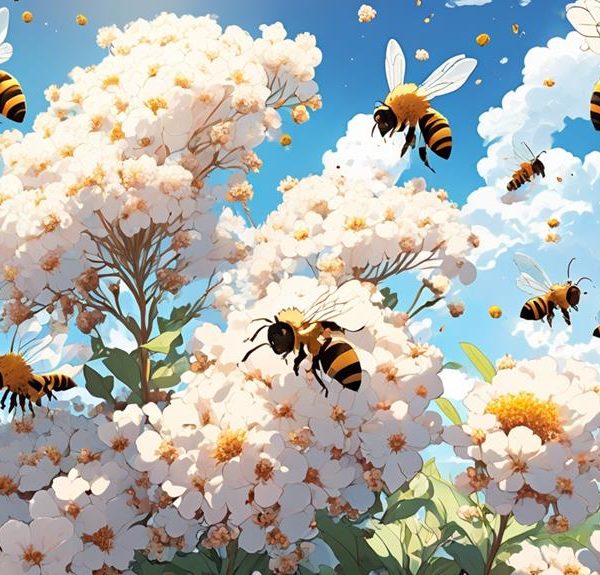Find out if bees are truly attracted to brugmansia, and how this relationship can impact your gardening strategy.
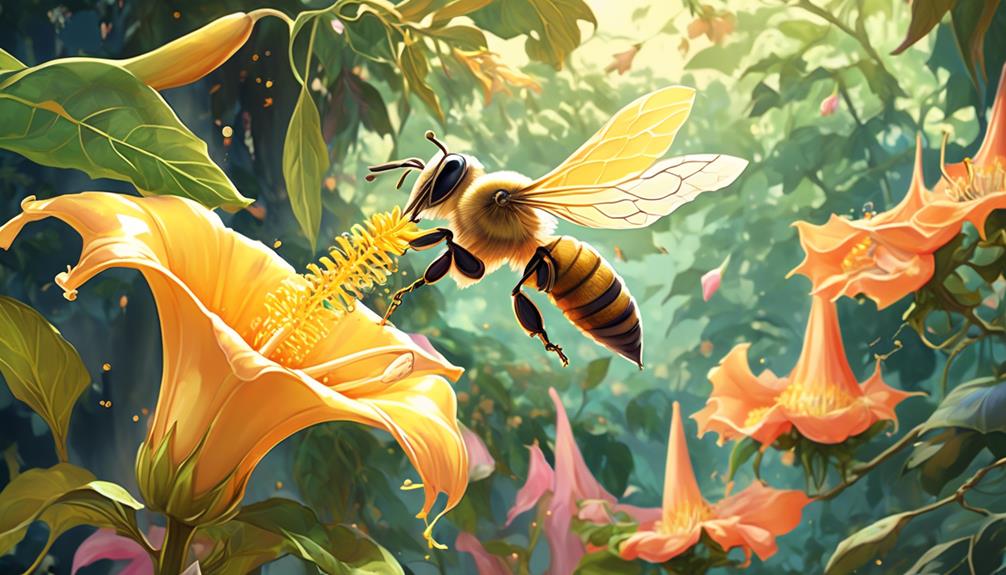
Do Bees Like Brugmansia
You've likely heard the theory that bees are attracted to brugmansia plants, but is there any truth to this claim?
Brugmansia, commonly known as Angel's Trumpet, is a genus of seven species of flowering plants known for their large, fragrant flowers.
They're visually appealing to many garden enthusiasts, but do they hold the same allure for our buzzing friends?
As we explore this topic further, you'll discover surprising insights about the relationship between bees and brugmansia, which might just reshape your gardening strategy.
Key Takeaways
- Brugmansia plants have large, fragrant, trumpet-shaped flowers in a variety of colors.
- Bees are attracted to Brugmansia due to its vibrant colors and intoxicating scent.
- Bees inadvertently transfer pollen while collecting nectar from Brugmansia flowers.
- The relationship between bees and Brugmansia is a mutualistic symbiosis, benefiting both parties.
Understanding Brugmansia Plants
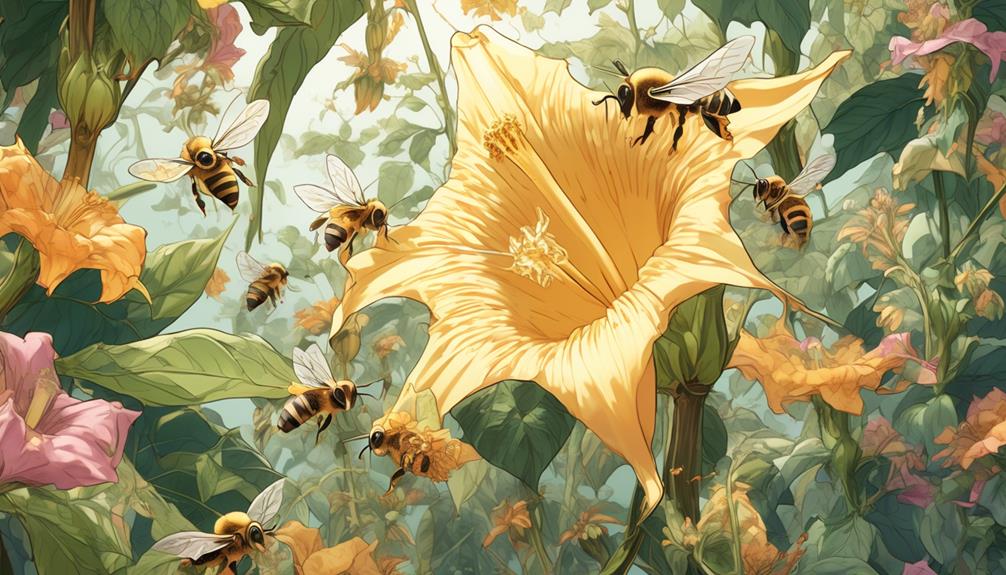
Before diving into the relationship between bees and Brugmansia, let's first understand what exactly a Brugmansia plant is. Commonly known as Angel's Trumpet, Brugmansia is a genus of seven recognized species of flowering plants in the Solanaceae family. These woody trees or shrubs, native to subtropical regions of South America, are renowned for their large, fragrant, trumpet-shaped flowers.
You'll find them in shades of white, yellow, pink, orange, green, or red. They're aesthetically pleasing, but don't be fooled by their beauty. All parts of the Brugmansia plant are poisonous, containing toxic alkaloids that can cause hallucinations, delirium, or even death if ingested or absorbed through the skin.
However, these plants have a unique survival strategy. They're night-blooming and their intoxicating scent attracts pollinators. Brugmansia species are adapted for pollination by moths, with long, trumpet-shaped flowers and strong nocturnal fragrance. But what about bees? Do they find these plants as appealing as moths do?
While we'll delve into this question in the next section, it's essential to understand the nature of Brugmansia plants first. Informed knowledge of these plants will help you understand the dynamic relationship between them and their potential pollinators.
The Role of Bees in Pollination
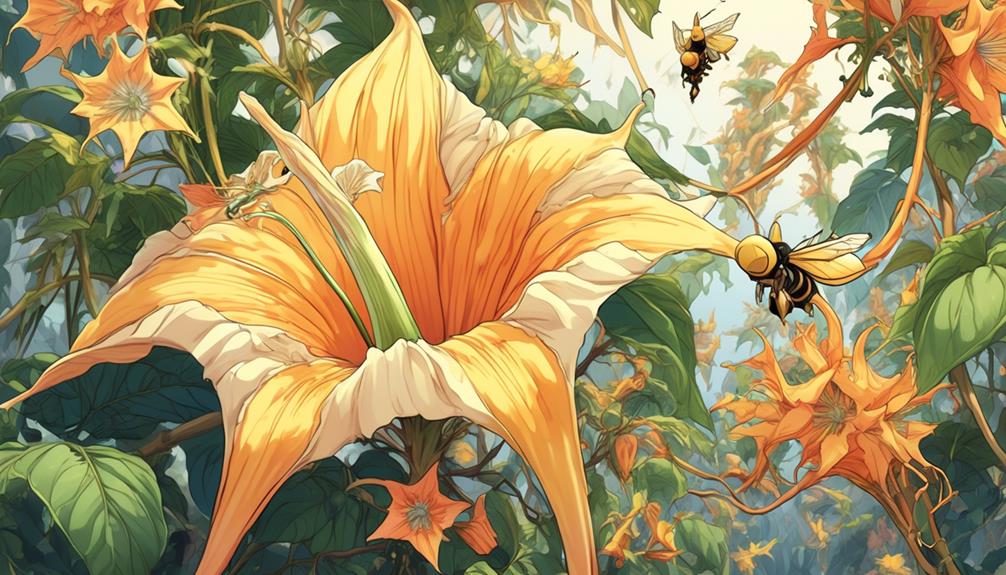
To fully grasp the potential interaction between bees and Brugmansia, you'll need to understand the crucial role that bees play in the process of pollination. As key pollinators, bees perform an essential function in the life cycle of plants, facilitating their sexual reproduction.
When bees land on a flower to collect nectar, they inadvertently gather pollen on their bodies. As they move from one flower to the next, some of this pollen rubs off onto the female parts of these flowers, enabling fertilization. This transfer of pollen is what we refer to as pollination.
Bees aren't just accidental pollinators, though. Their bodies are perfectly designed for the job. They've stiff hairs and special pouches on their legs to collect and transport pollen. Their keen sense of smell helps them locate flowers, and their colour vision enables them to identify different types of flowers.
In the context of Brugmansia, bees' role in pollination is vital for the plant's survival and propagation. Brugmansia's large, trumpet-shaped flowers are an attractive nectar source, and it's the bees that help ensure its pollen reaches other flowers for successful fertilization.
Brugmansia and Bee Interactions
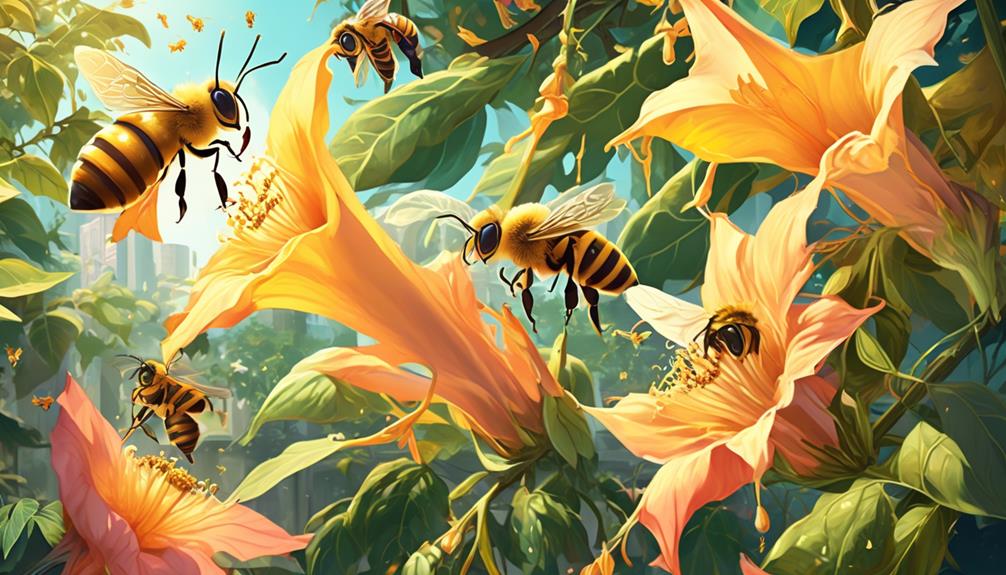
Given this pivotal role of bees in Brugmansia's life cycle, let's take a closer look at their interactions. Bees are attracted to Brugmansia due to its vibrant colors and intoxicating scent. As they move from flower to flower, they inadvertently transfer pollen, facilitating the plant's reproduction.
However, it's not a one-way street. Brugmansia provides bees with nectar, a crucial energy source. But what does this interaction look like in more detail? Let's examine in the table below:
Bee Activity | Result for Brugmansia |
|---|---|
Bee lands on flower | Pollen sticks to bee's body |
Bee moves to another flower | Pollen is transferred, enabling fertilization |
Bee consumes nectar | Bee gains energy, Brugmansia loses some nectar |
Bee returns to hive | Some pollen may be taken to the hive |
This symbiosis is a classic example of mutualistic relationships in nature. Bees rely on Brugmansia for sustenance, while Brugmansia gets a helping hand in reproduction. It's a delicate balance, highlighting the interconnectedness of our ecosystem. This underlines the importance of preserving both bees and Brugmansia, as their survival directly impacts each other.
Factors Affecting Bee Attraction
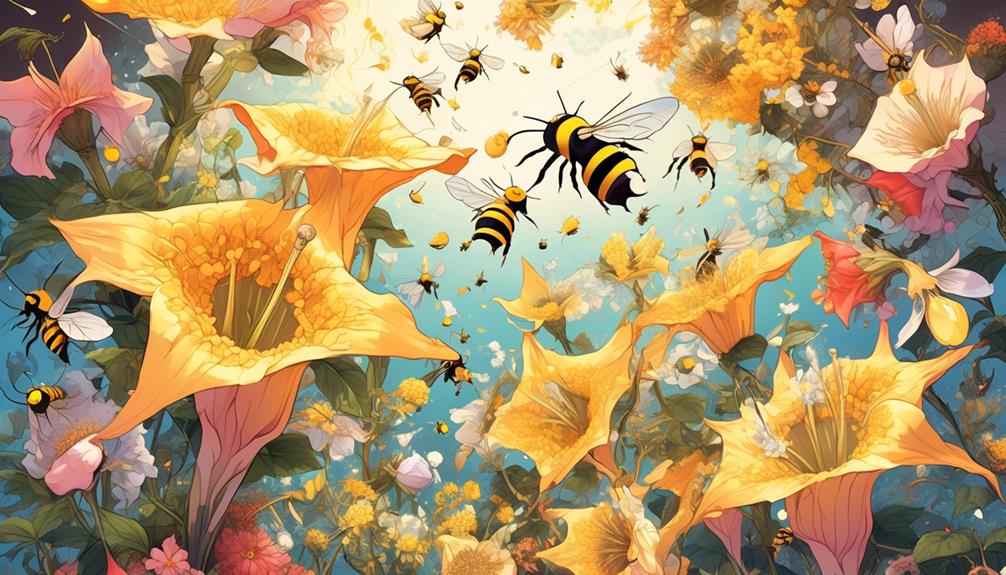
Understanding the allure of Brugmansia for bees involves delving into various factors that influence their attraction.
First, let's consider the flower's physical traits. Brugmansia, with its large, trumpet-shaped flowers, provides an easily accessible source of nectar and pollen. The color and scent of the flower also play crucial roles. Bees are particularly attracted to bright colors like yellow and blue, and Brugmansia's strong, sweet smell can lure bees from a distance.
Secondly, consider the timing of blooming. Brugmansia is a night blooming plant, and while many bee species are diurnal, certain species like the nocturnal bees could be attracted to it.
The third factor is the availability of resources. Bees are more likely to visit flowers that offer abundant nectar and pollen, and Brugmansia is a generous provider of both.
Lastly, think about local competition and predators. In areas where Brugmansia grows, if there's a lack of other nectar and pollen sources, or if the plant's predators are few, bees might be more inclined to visit. However, this doesn't necessarily mean they 'like' Brugmansia—it may be a matter of survival.
Maximizing Your Garden for Bees

If you're keen on attracting bees to your garden, optimizing the layout, plant selection, and maintenance practices could significantly increase their visitation. Planting a variety of native flowering species that bloom at different times of the year ensures a continuous food source. Crucially, you must consider that bees are drawn to flowers rich in nectar and pollen, such as brugmansia, which provide essential nutrients.
Your garden layout should be planned to maximize sunlight, as bees are most active in bright, sunny conditions. Cluster similar plants together to create a larger target for bees, making it easier for them to find the blooms.
Avoid using pesticides, especially those containing neonicotinoids, as they're harmful to bees. Instead, opt for organic gardening practices and encourage natural predators to manage pests. Providing a water source, like a shallow dish with pebbles for landing spots, can also help attract bees.
Lastly, consider providing shelter by leaving some areas of your garden undisturbed or installing bee hotels. These measures encourage bees to establish colonies nearby, thereby improving pollination in your garden.
Following these scientifically-informed practices, you'll create a bee-friendly environment, contributing to ecosystem health while boosting your garden's productivity.
Frequently Asked Questions
What Other Insects Are Attracted to Brugmansia Plants?"
You're curious about other insects attracted to brugmansia plants.
Brugmansia, with their fragrant, trumpet-shaped flowers, attract a variety of insects.
Moths, particularly the Sphinx moth, are drawn to its scent during the night.
Butterflies and hummingbird moths also find them appealing.
However, keep an eye out for less welcome visitors like aphids, whiteflies, and spider mites, which can cause damage to the plant.
How Can I Safely Introduce Bees to My Brugmansia Garden?"
You're looking to introduce bees to your Brugmansia garden, right?
Start by planting bee-friendly flowers around. These will attract bees, providing a food source.
Bees love a water source too. Add a birdbath or small pond.
Avoid using pesticides, they're harmful to bees.
Also, consider getting a bee house or hive. It's a safe place for bees to live.
Once they find your garden a safe and food-rich place, they'll stick around.
What Species of Bees Are Most Likely to Be Attracted to Brugmansia?"
You're likely to attract a variety of bee species to your Brugmansia, but honeybees and bumblebees are most common. These species are particularly drawn to the plant's large, trumpet-shaped flowers, which offer ample nectar.
However, remember that bee attraction can vary based on local species and availability of other food sources. It's best to observe your own garden to see which types of bees frequent your Brugmansia.
Are There Specific Varieties of Brugmansia That Bees Prefer?"
You're asking if certain varieties of brugmansia are more appealing to bees. Research hasn't definitively identified a preference. Bees are generally attracted to the nectar and pollen of these plants, regardless of the variety. But it's important to note, other factors like flower color and scent could play a role.
Can the Presence of Brugmansia Plants Impact the Health of a Bee Colony?"
You're right to consider the health of bee colonies when introducing new plants.
Brugmansia, while attractive to some pollinators, contains toxic alkaloids which can impact bees negatively.
If bees ingest too much, it can lead to their death.
Conclusion
You've learned that brugmansia plants, while enchanting, aren't a bee's first choice due to their toxicity. Bees play a critical role in pollination, but their interactions with these plants are minimal. Factors such as nectar availability affect bee attraction.
To maximize your garden for bees, opt for bee-friendly plants. Remember, understanding plant-bee relationships is key in maintaining a thriving ecosystem. Keep exploring, keep learning, and keep fostering a bee-friendly environment.

